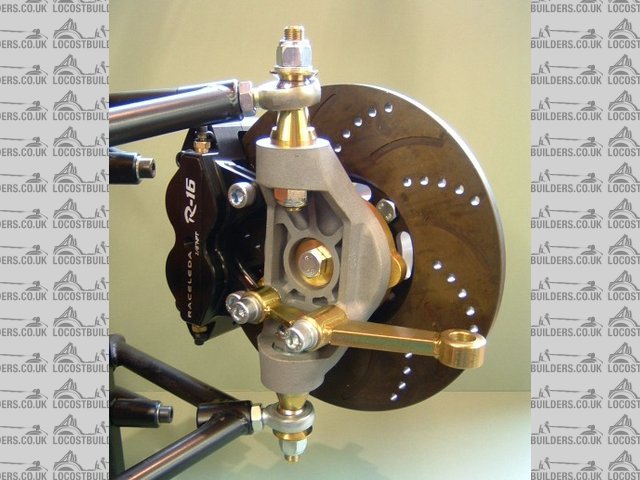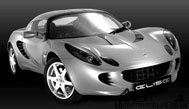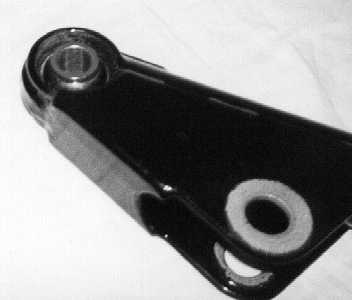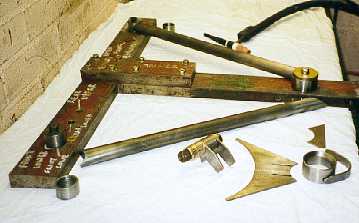andyd
|
 posted on 15/11/06 at 10:53 PM posted on 15/11/06 at 10:53 PM |

|
|
Using rod ends as opposed to ball joints
What does the panel think of using a rod end in the manner shown in this photo to connect the upright to the bottom wishbone?
Strong enough wishbone design?
 
Rescued attachment DSC0004.JPG
Andy

|
|
|
|
|
flak monkey
|
| posted on 15/11/06 at 11:01 PM |

|
|
Having busted a rose joint on the outboard end of a top wishbone, and now understanding why, thanks to the gents on this site, i wouldnt use it on a
road car.
David
Sera
http://www.motosera.com
|
|
|
Fatgadget
|
| posted on 15/11/06 at 11:02 PM |

|
|
For a road car, bling bling comes to mind.
|
|
|
andyd
|
| posted on 15/11/06 at 11:06 PM |

|
|
quote:
Originally posted by flak monkey
Having busted a rose joint on the outboard end of a top wishbone, and now understanding why, thanks to the gents on this site, i wouldnt use it on a
road car.
David
David, can you enlighten me as to the understanding or at least maybe the thread that helped you to your conclusion?
Andy

|
|
|
andyd
|
| posted on 15/11/06 at 11:08 PM |

|
|
quote:
Originally posted by Fatgadget
For a road car, bling bling comes to mind.
I fail to see the relevance. Rod ends are not expensive and the fabrication of the wishbone would be cheaper as there's less material there!
If you're referring to the uprights themselves then yes they aren't cheap but then I'm designing my own and a mate is going to be
CNC'ing them up for me at cost but that's not related to the question I asked. 
Andy

|
|
|
flak monkey
|
| posted on 15/11/06 at 11:14 PM |

|
|
quote:
Originally posted by andyd
David, can you enlighten me as to the understanding or at least maybe the thread that helped you to your conclusion?
Certainly:
http://locostbuilders.co.uk/viewthread.php?tid=37830
Granted it was an 8mm rod end, but the points made are all valid. My understanding is better after that, and having just designed the braking system
for our new car am not suprised it broke in hindsight!!
David
Sera
http://www.motosera.com
|
|
|
andyd
|
 posted on 15/11/06 at 11:33 PM posted on 15/11/06 at 11:33 PM |

|
|
Thanks David for the pointer to all the good info. Probably best to stick to the usual ball joints is my conclusion. 
Andy

|
|
|
flak monkey
|
| posted on 15/11/06 at 11:37 PM |

|
|
Spherical bearings are the way to go as far as i am concerned. Needs a bit more careful design, but it is what we now use for our FSAE cars.
Sera
http://www.motosera.com
|
|
|
Phil.J
|
| posted on 16/11/06 at 09:05 AM |

|
|
Durability is the main issue, and this will come down to quality of the joints. Unfortunately rod ends are expensive if you want good quality, if you
are only paying say £10 per joint I wouldn't expect them toi last more than a month on the road. On the other hand if you are buying Goldline
quality joints at say £60 per joint then they might well last for a couple of years on the road.
Nick Skidmore is the man to ask about the specs. of the joints to use, and also to ask him if he has any Goldline quality joints at bargain prices!
|
|
|
procomp
|
| posted on 16/11/06 at 09:35 AM |

|
|
Hi one other thing to consider is the extra amout of movment required by a joint for use on the upright wich usually means a high angular version is
needed.
cheers matt
|
|
|
NS Dev
|
| posted on 16/11/06 at 09:38 AM |

|
|
yep, transit joint is much better for road use.
I sue the transit joints top and bottom on my grasser, and will on the new one too, a £6 or so a pop for a joint that is dirt proof and very tough it
can't be beaten!
Retro RWD is the way forward...........automotive fabrication, car restoration, sheetmetal work, engine conversion
retro car restoration and tuning
|
|
|
Syd Bridge
|
| posted on 16/11/06 at 05:12 PM |

|
|
A spherical bearing in a proper housing is the sensible thing to do.
Cheers,
Syd. 
|
|
|
JB
|
| posted on 16/11/06 at 05:26 PM |

|
|
As Syd says the sensible way is to use a spherical bearing in a housing.
Ideally spherical rod ends should only be loaded in tension and compression, in the picture of the upright the SRE`s top and bottom are not loaded
this way and in that respect I would not use them for top and bottom ball joints.
I also dislike the way they are mounted so far away from the alloy housing on towers in single shear.
For a road car I prefer to use road car ball joints and design the upright and wishbone to suit.
John
|
|
|
t.j.
|
 posted on 16/11/06 at 05:40 PM posted on 16/11/06 at 05:40 PM |

|
|
wat is the difference?
Rose joint or spherical bearing?
I want to use at rear 3 of them;
two on the lower wishbone and 1 at the top
low 2 of m12 and top 1 of m16
|
|
|
andyd
|
| posted on 16/11/06 at 10:31 PM |

|
|
Do a google image search for spherical bearing... you'll get plenty of hits.
Basically they are similar to just the eye part of a rod end i.e. without the rod part 
As previous posts have said they need to be held by something to be of use as opposed to being able to be screwed into or onto something. Find some
images and my description will make more sense... well, maybe! 
[Edited on 16/11/2006 by andyd]
Andy

|
|
|
t.j.
|
| posted on 17/11/06 at 07:09 AM |

|
|
So the rose-joint is a spherical ball in a joint which has tread.
A spherical bearing is only the spherical ball in a bearing which without a possiblity to attache?
|
|
|
JoelP
|
| posted on 17/11/06 at 08:32 AM |

|
|
basically yes, it allows you to design a stronger housing. 
|
|
|
t.j.
|
| posted on 17/11/06 at 12:08 PM |

|
|
To bad, i've designed every thing using rose joints
|
|
|
dougal
|
| posted on 17/11/06 at 01:26 PM |

|
|
ive been following your threads recently involving your hubs with interest recently.
ill post up some pics next week for you of mine.
basically the top joint is the same as shown- using a 1/2" bore 5/8 thread. the bottom joint is a spherical joint but used in the same plain as
you suggest.
i have concerns as to the strength of this bottom joint as it will have the cars weight applied to it.
However i have seen it done many times on single seaters. guess ill find out soon.
|
|
|
andyd
|
| posted on 17/11/06 at 04:44 PM |

|
|
quote:
Originally posted by dougal
ive been following your threads recently involving your hubs with interest recently.
Hi Dougal... I assume this is directed at me as the initiator of this thread?
If so I just want to point out that the photo of the upright I started this thread with is from the Raceleda german website and not actually anything
to do with me. 
I was using it as an example to help me design my own setup. So far I've only drawn up my hub and stub axle and I've changed my mind on
the bearing sizes and brake components a couple of times so even those aren't finalised. 
However in terms of the original thread subject, I'm now thinking I may machine up some kind of carrier for a spherical bearing made from steel
which I'll weld as an integral part of the wishbone. This may turn out to be a PITA though so I may just go with "standard" ball
joints. I guess it'll depend how much info I can obtain for the specs of various spherical bearings based on someone's previous comment
about having to use ones with enough capacity to cope with the full suspension travel.
Andy

|
|
|
JB
|
| posted on 17/11/06 at 05:45 PM |

|
|
Using Spherical Bearings
I have designed and made my own wishbones using ball joints at the upright and high angle spherical bearings at the chassis. I have 130mm of wheel
movement.
It was a lot of work............
The sphericals are held in with circlips and 638 Loctite. First I machined all the housings slightly under size (bore too small) but the circlip
grooves the correct depth for the finished bore.
Then I welded the housings into my wishbones and finished them to size. I used reamers to do this. The reamers were slightly tapered so they would
locate in the housing then the last bit was parallel so it would take them to size.
The lower ball joint was a easy in comparision. Again made under size then bored to suit after welding. The ball joint is a press fit.
The upper ball joint is bolt in Jaguar.
It is very difficult to design a suspension system that is structurally good (ie SRE`s loaded in tension and compression and NOT bending) and retain
easy adjustment of the suspension.



Note finger plates around the housings.
More details and pictures HERE
John
|
|
|













